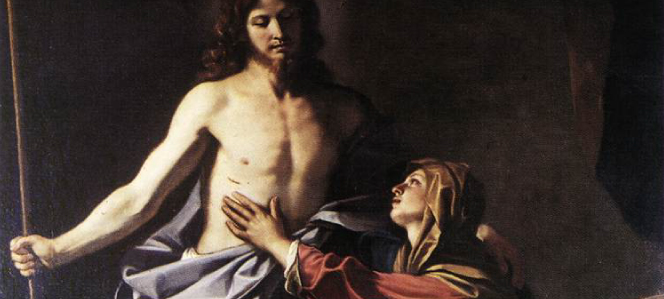Did the Virgin Mary know about the Resurrection before it happened?
There’s a gap of thirty years, called the “silent years” of Jesus, in which Scripture simply doesn’t tell us what happened between Jesus’ infancy and the beginning of His public ministry. But there’s one interruption to this silence, a single event that Scripture records from the youth of Christ: the finding in the Temple (Luke 2:41-52).
What happens in the finding of the Temple? Think about it from Mary’s perspective. Christ goes up with Mary and Joseph to Jerusalem for the Passover. There, He’s missing, separated from them, for three days. But this seeming catastrophe is actually a result of Christ’s need to be about His Father’s business (cf. Luke 2:49), and after three days (Lk. 2:46), Mary is reunited with her Son.
Out of all of the events that occurred in the first thirty years of Christ’s life, what’s St. Luke’s reason for recording this one? It’s because it’s a prefigurement of the Death and Resurrection of Christ. We see these themes again in Luke 18:31-33, in which Christ explains to His Apostles what’s about to take place:
“Behold, we are going up to Jerusalem, and everything that is written of the Son of man by the prophets will be accomplished. For he will be delivered to the Gentiles, and will be mocked and shamefully treated and spit upon; they will scourge him and kill him, and on the third day he will rise.”
And of course, all of this begins with Passover, which Luke describes as “the day of Unleavened Bread, on which the passover lamb had to be sacrificed” (Luke 22:7).
In other words, the finding in the Temple is a prophecy of the Death and Resurrection of Christ, and a prophecy that Jesus meant specifically for His Mother. Nobody besides Mary and Joseph is described as witnessing the event, and Joseph isn’t alive by the time of Christ’s death, which is why he isn’t mentioned during the public ministry of Christ.
So Jesus is preparing His Mother for His Passion and Resurrection. And while we’re only told about this instance, it’s reasonable to conclude that there were plenty of other instances of the same type. “But there are also many other things which Jesus did; were every one of them to be written, I suppose that the world itself could not contain the books that would be written” (John 21:25).
What’s Mary’s reaction to this? Does she understand? Or is she like the Apostles in Luke 18, who “understood none of these things; this saying was hid from them, and they did not grasp what was said” (Luke 18:34)?
Scripture doesn’t tell us explicitly. We don’t get to know exactly what’s going through Mary’s mind during Good Friday and Holy Saturday, or whether and when she realized that she would be reunited with her Son on the third day. But we do get a few important clues.
The first is that the Finding in the Temple is in Luke’s Gospel at all. Luke tells the story of the birth and infancy of Christ from Mary’s perspective, and that’s true of the Finding in the Temple, as well. After recounting the events in the Temple, Luke tells us that “his mother kept all these things in her heart” (Luke 2:51). So the first to recognition the connection between this event and the Resurrection seems to have been Mary, as a result of her meditation on the life of Christ.
But that alone doesn’t tell us whether she realized before or after Easter. However, there’s another clue that suggests she knew about the Resurrection before it happened.
Pay close attention to who’s at Calvary and who’s at the Empty Tomb. Mary is close by Christ’s side during His Passion. At Calvary, after “all the disciples forsook him and fled” (Matthew 26:56), and “all his acquaintances and the women who had followed him from Galilee stood at a distance” (Luke 23:49), there are but a handful of people at the foot of the Cross: “standing by the cross of Jesus were his mother, and his mother’s sister, Mary the wife of Clopas, and Mary Mag′dalene” (John 19:25), with the Apostle John standing near the Virgin Mary (Jn. 19:26).
On the third day, however, the Virgin Mary’s not there at the Empty Tomb. “And when the sabbath was past, Mary Mag′dalene, and Mary the mother of James, and Salo′me, bought spices, so that they might go and anoint him” (Mark 16:1). Why not?
The clue is the last half of that verse: they have gone to the Tomb to anoint Him. They’re expecting to find a dead Body. Recall Mary Magdalene’s tearful reaction to not being able to find His Corpse (John 20:2, 11-13). She hasn’t lost faith in Christ, but she still thinks that he’s dead. Likely, she believes something like what her sister Martha said of Lazarus: “I know that he will rise again in the resurrection at the last day” (John 11:24). It’s a belief in the Resurrection, but as a far-off event.
But we don’t see the Virgin Mary react that way. We don’t even see her going to anoint His Corpse. I would suggest that this is because she knows that there won’t be a dead Body to anoint. Christ has shown her that His Father’s business was for Him to go up to Jerusalem, be separated from His Mother for three days, and then return to her. While the faithful women at the Tomb are looking to prepare His Body for the Resurrection on the last day, the Virgin Mary knows that we won’t have to wait that long. Let us join Mary today in her sorrows, but also in her joyful anticipation of Easter.
